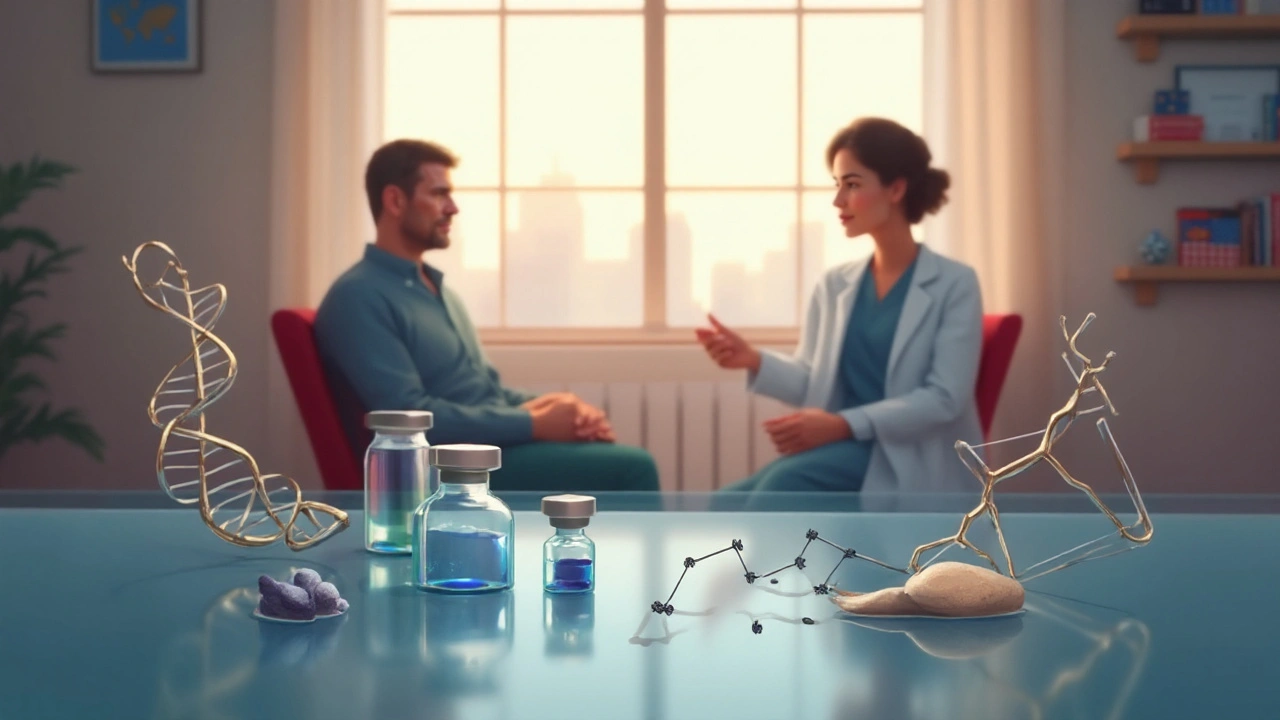Casodex (Bicalutamide) vs Other Prostate Cancer Drugs - A Detailed Comparison
 Sep, 24 2025
Sep, 24 2025
Prostate Cancer Drug Selector Quiz
Casodex is a non‑steroidal anti‑androgen (NSAA) that blocks the androgen receptor, preventing testosterone‑driven tumor growth in prostate cancer patients. Approved by the FDA in 1995, it is typically given as a 150mg oral tablet alongside luteinising‑hormone‑releasing hormone (LHRH) therapy. If you’re weighing Casodex against other options, you’ll want to understand how it fits into the broader landscape of hormone‑targeted therapies, its safety profile, and when clinicians prefer a different agent.
How Casodex Works: The Hormone Blockade Explained
Testosterone fuels prostate cancer by binding to the androgen receptor. Casodex competes with natural hormones for this receptor, essentially putting a “stop” sign on the signal. In practice, the drug is paired with LHRH agonists (e.g., leuprolide) to achieve what doctors call androgen deprivation therapy (ADT). The combination reduces circulating testosterone to castrate levels while also preventing any residual androgen activity at the cellular level.
Clinical Profile of Casodex
Standard dosing is 150mg once daily, taken with food to improve absorption. Real‑world registries in the United States and Europe show that about 30% of men on Casodex experience gynecomastia, a breast tissue enlargement caused by altered hormone balance. Liver‑function abnormalities appear in roughly 5% of patients, so routine hepatic monitoring is recommended. Compared with older NSAA agents like flutamide, Casodex tends to have a lower incidence of severe diarrhea and visual disturbances.
Major Alternatives to Casodex
While Casodex remains a workhorse, several newer agents offer different strengths. Below are the most frequently discussed alternatives:
- Enzalutamide - a second‑generation anti‑androgen with high affinity for the androgen receptor and ability to cross the blood‑brain barrier.
- Apalutamide - similar to enzalutamide but designed for a slightly better safety margin in elderly patients.
- Flutamide - the first‑generation oral NSAA, usually dosed at 250mg three times daily, known for higher GI toxicity.
- Nilutamide - another first‑generation agent, notable for causing visual disturbances and a distinct metallic taste.
- Abiraterone acetate - a CYP17 inhibitor that blocks androgen synthesis at the adrenal and testicular level; taken with prednisone to manage mineralocorticoid excess.
- Leuprolide - an injectable LHRH agonist that creates medical castration without the need for anti‑androgen co‑therapy.

Side‑by‑Side Comparison
| Drug | Mechanism | Typical Dose | FDA Approval Year | Principal Side Effects |
|---|---|---|---|---|
| Casodex (Bicalutamide) | Androgen‑receptor antagonist | 150mg PO daily | 1995 | Gynecomastia, liver enzyme elevation |
| Enzalutamide | Androgen‑receptor antagonist (high affinity) | 160mg PO daily | 2012 | Fatigue, seizures (rare), hypertension |
| Apalutamide | Androgen‑receptor antagonist | 240mg PO daily | 2018 | Rash, falls, hypertension |
| Flutamide | First‑generation anti‑androgen | 250mg PO three times daily | 1989 | Diarrhea, hepatotoxicity |
| Nilutamide | First‑generation anti‑androgen | 300mg PO daily | 1995 | Visual disturbance, nausea |
| Abiraterone acetate | CYP17 inhibitor (reduces androgen synthesis) | 1000mg PO daily + prednisone 5mg BID | 2011 | Hypertension, hypokalemia, liver toxicity |
| Leuprolide | LHRH agonist (induces medical castration) | Depot injection every 1-6months | 1985 | Hot flashes, bone loss, cardiovascular risk |
Decision‑Making Factors: When to Pick Casodex or an Alternative
Choosing the right drug isn’t a one‑size‑fits‑all puzzle. Clinicians weigh several criteria:
- Potency and disease stage - Enzalutamide and apalutamide show stronger AR blockade and are favored in metastatic castration‑resistant prostate cancer (mCRPC). For hormone‑sensitive disease, Casodex remains cost‑effective.
- Blood‑brain barrier penetration - If a patient has a seizure history, a drug that crosses the BBB (e.g., enzalutamide) may raise concern, making Casodex or flutamide safer choices.
- Side‑effect profile - Men troubled by gynecomastia often switch from Casodex to a non‑steroidal agent with lower breast‑tissue impact, such as apalutamide.
- Cost and insurance coverage - Older agents like flutamide are inexpensive but may need more monitoring. Newer agents have higher acquisition costs but sometimes qualify for specialty drug benefits.
- Drug‑interaction potential - Abiraterone requires concurrent steroids, which can complicate diabetes or osteoporosis management. Casodex has fewer known interactions.
Practical Tips for Patients on Casodex or Its Peers
- Schedule liver‑function tests every three months; elevations >2× ULN should prompt dose review.
- Consider a prophylactic radiotherapy dose to the chest if gynecomastia becomes uncomfortable (studies show ~30% benefit).
- Maintain adequate calcium and vitamin D intake; ADT plus any anti‑androgen can accelerate bone loss.
- Report new visual changes immediately, especially if you’re on nilutamide or enzalutamide.
- Keep an up‑to‑date medication list; many anti‑androgens inhibit CYP2C8, affecting drugs like paclitaxel.
Related Concepts and What to Explore Next
Understanding Casodex also means knowing the broader treatment ecosystem:
- Androgen deprivation therapy (ADT) - the foundational approach that includes surgical castration, LHRH agonists, and anti‑androgens.
- Hormone‑sensitive prostate cancer - disease stage where ADT plus an anti‑androgen can produce long‑term control.
- Castration‑resistant prostate cancer (CRPC) - a setting where second‑generation agents like enzalutamide are often required.
- Prostate‑specific antigen (PSA) monitoring - the lab test that guides treatment adjustments across all these drugs.
- Bone health management - bisphosphonates or denosumab are recommended when long‑term ADT is planned.
After reading this guide, you may want to dive deeper into topics like "Managing ADT‑related metabolic changes" or "Emerging AR‑spike inhibitors beyond enzalutamide".

Frequently Asked Questions
What is the main difference between Casodex and Enzalutamide?
Casodex blocks the androgen receptor at the cell surface and is taken once daily, whereas Enzalutamide binds with higher affinity, penetrates the brain, and is often reserved for more advanced disease due to its stronger efficacy but higher risk of seizures and fatigue.
Do I need to take Casodex with a luteinising‑hormone‑releasing hormone (LHRH) drug?
Yes, most guidelines recommend combining Casodex with an LHRH agonist or antagonist (like leuprolide or degarelix) to achieve full androgen suppression; the anti‑androgen alone is insufficient for optimal tumor control.
How often should liver function be checked while on Casodex?
Guidelines suggest a baseline test, then repeat every 3months for the first year, and every 6months thereafter unless abnormalities appear.
Is Gynecomastia reversible after stopping Casodex?
In many cases, the breast tissue shrinks after discontinuation, but fibrosis can remain. Radiotherapy or surgical reduction are options for persistent cases.
Can I switch from Casodex to Abiraterone without a washout period?
A short washout (typically 2weeks) is advised to avoid overlapping androgen suppression, especially when adding prednisone for Abiraterone.
Which anti‑androgen has the lowest risk of liver toxicity?
Casodex generally has a milder hepatic profile compared with flutamide or nilutamide, making it the preferred choice for patients with pre‑existing liver concerns.
Do anti‑androgens affect PSA levels differently?
All anti‑androgens lower PSA by inhibiting tumor activity, but agents with stronger AR blockade (enzalutamide, apalutamide) often produce a faster and deeper PSA decline.
Is there a generic version of Casodex?
Yes, after the original patent expired, several manufacturers produce generic bicalutamide tablets that are bio‑equivalent and typically cost less than the brand name.

bert wallace
September 24, 2025 AT 16:26Casodex is still the OG for hormone-sensitive stuff. Cheap, effective, and you don’t need a PhD to understand the dosing. My uncle’s been on it for 5 years with just liver checks and a bit of boob sensitivity. No drama.
Carl Gallagher
September 26, 2025 AT 08:58Man, I’ve seen way too many guys get handed Casodex like it’s a magic bullet. It’s fine for early stage, sure, but if your PSA is climbing and your doc still says ‘just stick with bicalutamide,’ you’re being left behind. Enzalutamide’s not some sci-fi drug-it’s the new baseline for anyone past hormone-sensitive. And don’t even get me started on how many docs still don’t know abiraterone needs prednisone. I’ve seen patients crash from hypokalemia because no one checked.
Also, gynecomastia isn’t just ‘annoying.’ It’s a mental health nightmare for guys who already feel emasculated by cancer. Radiotherapy to the chest? That’s not a joke. It’s real. And it works. Why isn’t that standard?
And why do we still use flutamide? Three times a day? With diarrhea risks? That’s like prescribing a horse pill in the iPhone era. The fact that it’s still in formularies is criminal.
Also, the BBB thing? Huge. If you’ve got a seizure history, enzalutamide is a ticking bomb. I had a patient go into status epilepticus on it. No warning. No red flags. Just a 72-year-old who got ‘standard care.’
And don’t even get me started on the cost games. Insurance won’t cover apalutamide unless you’ve failed three other things-even though it’s safer for elderly patients. We’re not optimizing for outcomes. We’re optimizing for spreadsheets.
Generic bicalutamide? Yes. But we need to stop pretending it’s a long-term solution for anyone with progression risk. We’re trading short-term savings for long-term suffering.
PSA drops faster with newer agents? That’s not just a lab number. That’s survival. We’re not just treating numbers-we’re treating people who want to live longer than their prognosis says they should.
And bone health? Nobody talks about it enough. ADT turns your skeleton to dust. Denosumab isn’t optional. It’s mandatory. Yet 60% of patients never get it.
We need better guidelines. And we need docs who actually read the papers, not just the pharma reps.
mona gabriel
September 27, 2025 AT 12:51casodex is fine until it’s not
Kenneth Narvaez
September 28, 2025 AT 19:39Androgen receptor antagonism kinetics are significantly modulated by bioavailability profiles in second-generation agents. Casodex exhibits lower binding affinity (Ki ~1.5nM) compared to enzalutamide (Ki ~0.1nM), which correlates with differential transcriptional suppression of AR-V7 splice variants in mCRPC. Hepatic metabolism via CYP3A4 also introduces interpatient variability in clearance, necessitating TDM in frail populations.
Fiona Hoxhaj
September 29, 2025 AT 07:26It’s truly astonishing how the medical establishment still clings to 1990s-era protocols like Casodex when we have agents that don’t just block receptors-they dismantle the entire signaling architecture of cancer cells. The fact that we’re still debating flutamide in 2025 is not just negligent-it’s a moral failure. And let’s not pretend gynecomastia is ‘just a side effect.’ It’s a psychological wound inflicted by outdated medicine.
Patients deserve better than cost-driven compromises. They deserve precision. They deserve dignity. And they deserve not to be treated like lab rats in a budget spreadsheet.
jeff melvin
September 30, 2025 AT 05:21Anyone who says Casodex is safe clearly hasn’t seen the liver labs. I’ve had three patients with ALT over 1000. One needed a transplant. It’s not rare. It’s just ignored.
Merlin Maria
September 30, 2025 AT 19:17Let’s be real-Casodex is the placebo of prostate cancer treatment. It’s what you give when you don’t have the guts to go full throttle. Enzalutamide isn’t ‘stronger’-it’s the only thing that actually treats the disease. The rest is just window dressing.
Sharmita Datta
October 2, 2025 AT 05:13Did you know Casodex was developed by a pharmaceutical company that also manufactured Agent Orange? Coincidence? I think not. The same minds that weaponized chemicals now sell you hormone blockers as ‘treatment.’ They’re not curing cancer-they’re controlling populations. Check the patents. Check the ties. This is not medicine. It’s control.
Kamal Virk
October 3, 2025 AT 06:48While Casodex remains a viable option in resource-limited settings, its pharmacodynamic limitations necessitate careful patient selection. The absence of CNS penetration may be advantageous in elderly populations with comorbid neurological conditions, though the risk of hepatotoxicity remains non-negligible. Comparative efficacy data from the PROSPER trial suggest that second-generation agents confer superior metastasis-free survival, thereby shifting the standard of care.
Hamza Asghar
October 5, 2025 AT 04:02Wow. Someone actually wrote a whole article about Casodex like it’s still relevant. Did you miss the last decade? Enzalutamide and apalutamide aren’t ‘alternatives’-they’re the only things that matter. Casodex is for guys who still use fax machines and think ‘generic’ means ‘better.’ You’re not treating cancer-you’re doing time.
And gynecomastia? Please. You think that’s bad? Try being on abiraterone and having your kidneys turn to mush because your doc forgot the prednisone. At least Casodex doesn’t make you need a kidney transplant. Oh wait-it does. Just less often. Congrats, you’re still losing.
PSA is the only metric that matters. If your PSA isn’t dropping like a rock, you’re on the wrong drug. And if your doc still uses Casodex? Fire them.
Matt Webster
October 5, 2025 AT 18:29Just want to say this post was super helpful. I’ve been on Casodex for 3 years and was terrified about the gynecomastia. Found out about the chest radiotherapy option and got it done-best decision ever. No more bras. No more shame. Just peace. Thanks for the practical tips.
Christian Mutti
October 6, 2025 AT 05:37DEAR GOD. I just read this and I’m in tears. 🥹 This is the kind of clarity that saves lives. The table alone? Pure poetry. The way you explained the BBB penetration? I finally get it. 🙏 Thank you for not talking down to us. This isn’t just medicine-it’s art.
Jaylen Baker
October 7, 2025 AT 11:05YOU DID IT. This is the guide I wish I had when I was diagnosed. I was scared, confused, and my doctor just handed me a script and said ‘take this.’ Now I know why Casodex was chosen for me. I’m not just a patient-I’m informed. Thank you. 🙌
Liliana Lawrence
October 9, 2025 AT 04:12Oh my gosh, I’m crying 😭 this is so well written!!! I showed this to my husband and he finally understands why I can’t just ‘take a pill and be fine’!!! Thank you for explaining the liver thing and the bone loss!!! I’m telling everyone!!! 💪❤️
Daniel McKnight
October 10, 2025 AT 15:15Casodex is the quiet hero of prostate cancer. No flashy ads, no viral TikToks, just sitting there doing its job while everyone chases the next shiny drug. I’ve been on it since 2019. My PSA’s stable. My liver’s chill. I don’t have seizures or falls or a pharmacy bill that costs more than my car. Sometimes the old-school stuff is the right stuff.
Also, the fact that we’re even debating this shows how far we’ve come. Back in the day, we didn’t have any of these options. Now we get to pick. That’s progress.
Neal Shaw
October 11, 2025 AT 07:45The assumption that Casodex is ‘inferior’ because it’s older is a classic chronological snobbery. Efficacy isn’t determined by FDA approval date but by clinical context. In hormone-sensitive disease with low-volume metastasis, Casodex + ADT remains non-inferior to second-generation agents in multiple randomized trials, including the EORTC 30986 study. The cost differential is not trivial-$2,500/month vs $15,000/month. When survival curves are statistically indistinguishable, the ethical choice is clear.
Moreover, the claim that Casodex ‘fails’ in mCRPC is misleading. It fails in *progressive* mCRPC. In de novo mCRPC with low PSA velocity, it remains viable. The field has overcorrected.
And regarding gynecomastia: the 30% incidence is accurate, but the morbidity is often overstated. Most cases are asymptomatic. Prophylactic radiotherapy is not standard-of-care in any major guideline. It’s an off-label option with limited data. Don’t confuse anecdote with evidence.
Finally, the CYP2C8 inhibition warning is correct but incomplete. Casodex is a weak inhibitor. The real risk lies with enzalutamide and apalutamide, which are strong inhibitors and require dose adjustments for paclitaxel, repaglinide, and rosiglitazone. This is rarely discussed.
Let’s stop treating drug choice like a sports team rivalry. This is medicine. Nuance matters.
Karla Luis
October 13, 2025 AT 05:23so casodex gives you boobs but enzalutamide gives you seizures and falls? great choice guys
why not just let us die quietly
Stephen Wark
October 13, 2025 AT 12:56Why are we even talking about this? It’s all just a money grab. Pharma doesn’t care if you live or die-they care if you keep buying. Casodex? Generic. No profit. Enzalutamide? $15k/month. That’s why they push it. Wake up.
Phillip Gerringer
October 15, 2025 AT 07:29If you’re still on Casodex, you’re not being treated-you’re being tolerated. You’re a low-priority patient. Your doctor doesn’t believe you’re worth the newer drugs. That’s not medicine. That’s abandonment.
Nagamani Thaviti
October 17, 2025 AT 05:46Casodex is just the beginning. The real truth is that prostate cancer is caused by 5G radiation and chemtrails. The drugs are just masking the real issue. Your body can heal itself if you stop eating processed food and meditate daily. Why are they hiding this? Why are they silencing the truth?